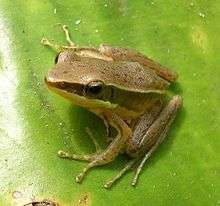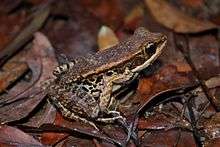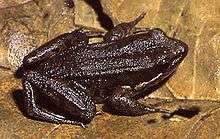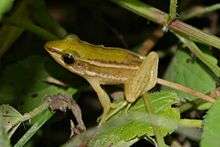Hylarana
| Hylarana | |
|---|---|
 | |
| A golden frog (Hylarana aurantiaca) | |
| Scientific classification | |
| Kingdom: | Animalia |
| Phylum: | Chordata |
| Class: | Amphibia |
| Order: | Anura |
| Family: | Ranidae |
| Subfamily: | Raninae |
| Genus: | Hylarana Tschudi, 1838 |
| Type species | |
| Hylarana erythraea Schlegel, 1837 | |
| Species | |
|
See text | |
| Synonyms[1] | |
| |
Hylarana, commonly known as golden-backed frogs, is a widespread genus of true frogs found in tropical Africa, Asia, and Australia. It includes around 84 to 96 valid species.[2]
Taxonomy
The generic name Hylarana derives from New Latin hyle ("wood" or "forest") and rana ("frog").[2] Hylarana was previously considered to be a subgenus of the genus Rana. It was recognized as a distinct genus in 2005.[3][4] Several genera were further split from Hylarana in 2006, but are now treated again as junior synonyms of Hylarana.[1]
Hylarana belongs to the subfamily Raninae of the true frog family Ranidae.[1]
Description
Hylarana are small to large-sized frogs. Males have an average snout-vent length of 27 to 85 mm (1.1 to 3.3 in), while females range from 38 to 92 mm (1.5 to 3.6 in). The nares (nostrils) are oval in shape and covered by a flap of skin. The tympanum is visible but is not covered by a supratympanic fold. Vomerine teeth and a pineal ocellus (parietal eye) are present. The toes are webbed, but the fingers are not.[2]
Distribution
Species of Hylarana are found from Sri Lanka to the Western Ghats of India, through Nepal and southern China and Taiwan, down to Southeast Asia to the Philippines and Papua New Guinea, and in Northern Australia. They are also found in tropical Africa.[4]
Species
Hylarana currently contains around 84 to 96 valid species, they are:[1][2][4][5]
- Hylarana albolabris (Hallowell, 1856)
- Hylarana albotuberculata (Inger, 1954) - Cabalian frog
- Hylarana amnicola Perret, 1977
- Hylarana arfaki (Meyer, 1875) - Arfak Mountains frog
- Hylarana asperrima Perret, 1977
- Hylarana attigua (Inger, Orlov, and Darevsky, 1999)
- Hylarana aurantiaca (Boulenger, 1904) - golden frog, small wood frog, common wood frog, Boulenger's golden-backed frog
- Hylarana aurata (Günther, 2003)
- Hylarana banjarana (Leong and Lim, 2003)
- Hylarana baramica (Boettger, 1900) - masked rough-sided frog, golden-eared rough-sided frog, Baram River frog, or brown marsh frog
- Hylarana caesari (Biju et al., 2014) - Maharashtra golden-backed frog
- Hylarana celebensis (Peters, 1872)
- Hylarana chalconota (Schlegel, 1837)
- Hylarana chitwanensis (Das, 1998)
- Hylarana crassiovis (Boulenger, 1920)
- Hylarana cubitalis (Smith, 1917)
- Hylarana daemeli (Steindachner, 1868) - Australian wood frog
- Hylarana darlingi (Boulenger, 1902)
- Hylarana debussyi (Van Kampen, 1910)
- Hylarana doni (Biju et al., 2014) - Don's golden backed frog
- Hylarana elberti (Roux, 1911)
- Hylarana erythraea (Schlegel, 1837) - common green frog, green paddy frog, leaf frog, or red-eared frog
- Hylarana eschatia (Inger, Stuart, and Iskandar, 2009)
- Hylarana everetti (Boulenger, 1882)
- Hylarana faber (Ohler, Swan, and Daltry, 2002)
- Hylarana flavescens (Jerdon, 1853) - Yellowish golden-backed frog
- Hylarana florensis (Boulenger, 1897) - Floresian frog
- Hylarana fonensis (Rödel and Bangoura, 2004)
- Hylarana galamensis (Duméril and Bibron, 1841)
- Hylarana garoensis (Boulenger, 1920)
- Hylarana garritor (Menzies, 1987)
- Hylarana glandulosa (Boulenger, 1882) - rough-sided frog or glandular frog
- Hylarana gracilis (Gravenhorst, 1829) - Gravenhorst's frog, Gravenhorst's golden-backed frog
- Hylarana grandocula (Taylor, 1920)
- Hylarana grisea (Van Kampen, 1913)
- Hylarana guentheri (Boulenger, 1882) - Günther's frog
- Hylarana hekouensis Fei, Ye, and Jiang, 2008 - Hekou frog
- Hylarana indica (Biju et al., 2014) - Indian golden-backed frog
- Hylarana intermedius (Rao, 1937) - Rao's golden-backed frog
- Hylarana igorota (Taylor, 1922)
- Hylarana jimiensis (Tyler, 1963)
- Hylarana kampeni (Boulenger, 1920)
- Hylarana kreffti (Boulenger, 1882)
- Hylarana labialis (Boulenger, 1887) - forest white-lipped frog
- Hylarana laterimaculata (Barbour and Noble, 1916) - lesser swamp frog
- Hylarana latouchii (Boulenger, 1899)
- Hylarana lemairei (de Witte, 1921)
- Hylarana leptoglossa (Cope, 1868) - long-tongued frog, Cope's Assam frog, or Cope's frog
- Hylarana lepus (Andersson, 1903)
- Hylarana longipes (Perret, 1960)
- Hylarana luctuosa (Peters, 1871) - mahogany frog or purple frog
- Hylarana luzonensis (Boulenger, 1896)
- Hylarana macrodactyla Günther, 1858 - Guangdong frog, three-striped grass frog, or marbled slender frog
- Hylarana macrops (Boulenger, 1897)
- Hylarana malabarica (Tschudi, 1838) - fungoid frog, Malabar fungoid frog
- Hylarana mangyanum (Brown and Guttman, 2002)
- Hylarana maosonensis Bourret, 1937
- Hylarana magna (Biju et al., 2014) - Large golden-backed frog
- Hylarana margariana Anderson, 1879
- Hylarana megalonesa (Inger, Stuart, and Iskandar, 2009)
- Hylarana melanomenta (Taylor, 1920)
- Hylarana menglaensis Fei, Ye, and Xie, 2008
- Hylarana milleti (Smith, 1921)
- Hylarana milneana (Loveridge, 1948)
- Hylarana mocquardi (Werner, 1901)
- Hylarana moellendorffi (Boettger, 1893)
- Hylarana moluccana (Boettger, 1895)
- Hylarana montanus (Rao, 1922) - Mountain golden backed frog
- Hylarana montivaga (Smith, 1921)
- Hylarana mortenseni (Boulenger, 1903)
- Hylarana nicobariensis (Stoliczka, 1870)
- Hylarana nigrovittata (Blyth, 1856) - sapgreen stream frog
- Hylarana novaeguineae (Van Kampen, 1909)
- Hylarana occidentalis (Perret, 1960)
- Hylarana papua (Lesson, 1826)
- Hylarana parkeriana (Mertens, 1938)
- Hylarana parvacola (Inger, Stuart, and Iskandar, 2009)
- Hylarana persimilis (Van Kampen, 1923)
- Hylarana picturata (Boulenger, 1920) - spotted stream frog
- Hylarana raniceps (Peters, 1871)
- Hylarana rufipes (Inger, Stuart, and Iskandar, 2009)
- Hylarana scutigera (Andersson, 1916)
- Hylarana serendipi (Biju et al., 2014) - Sri Lankan golden backed frog
- Hylarana siberu (Dring, McCarthy, and Whitten, 1990) - Siberut Island frog
- Hylarana signata (Günther, 1872) - striped stream frog
- Hylarana similis (Günther, 1873)
- Hylarana spinulosa (Smith, 1923)
- Hylarana sreeni (Biju et al., 2014) - Sreeni's golden-backed frog
- Hylarana supragrisea (Menzies, 1987)
- Hylarana taipehensis (Van Denburgh, 1909) - two-striped grass frog
- Hylarana temporalis (Günther, 1864) - bronzed frog, Günther's golden-backed frog
- Hylarana tipanan (Brown, McGuire, and Diesmos, 2000)
- Hylarana tytleri Theobald, 1868
- Hylarana urbis (Biju et al., 2014) - Urban golden-backed frog
- Hylarana volkerjane (Günther, 2003)
- Hylarana waliesa (Kraus and Allison, 2007)
See also
| Wikimedia Commons has media related to Hylarana. |
| Wikispecies has information related to: Hylarana |
References
- 1 2 3 4 Darrel Frost and the American Museum of Natural History. "Hylarana Tschudi, 1838". Amphibian Species of the World 5.5, an Online Reference.
- 1 2 3 4 S.D. Biju; Sonali Garg; Stephen Mahony; Nayana Wijayathilaka; Gayani Senevirathne; Madhava Meegaskumbura (2014). "DNA barcoding, phylogeny and systematics of Golden-backed frogs (Hylarana, Ranidae) of the Western Ghats-Sri Lanka biodiversity hotspoty, with the description of severn new species". Contributions to Zoology. 83 (4): 269–335.
- ↑ Liqiao Chen; Robert W. Murphy; Amy Lathrop; Andre Ngo; Nikolai L. Orlov; Cuc Tho Ho; Ildiko L. M. Somorjai (2005). "Taxonomic Chaos in Asian Ranid Frogs: An Initial Phylogenetic Resolution" (PDF). Herpetological Journal. 15: 231–243. ISSN 1175-5334.
- 1 2 3 Anna Gawor; Ralf Hendrix; Miguel Vences; Wolfgang Böhme; Thomas Ziegler (2009). "Larval morphology in four species of Hylarana from Vietnam and Thailand with comments on the taxonomy of H. nigrovittata sensu lato (Anura: Ranidae)". Zootaxa. Magnola Press. 2051: 1–25. ISSN 1175-5334.
- ↑ Ramlah Zainudin; Mustafa A. Rahman; Badrul Munir M. Zain; M.N. Shukor; R.F. Inger; A. Norhayati (2010). "Mating Calls Description of Five Species of Frogs from the Genus Hylarana Tschudi 1838 (Amphibia, Anura, Ranidae) from Sarawak, Malaysia" (PDF). Sains Malaysiana. 39 (3): 363–369.
%2C_Agumbe.jpg)






